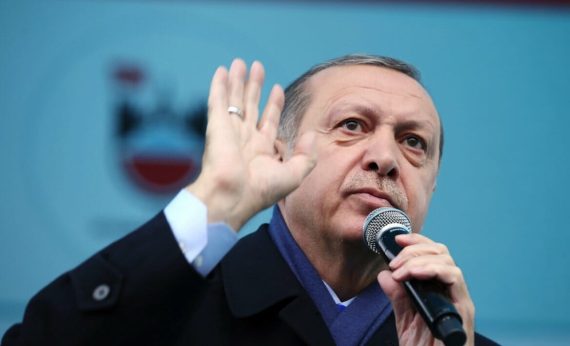On Sunday April 16, fifty-five million Turkish citizens will cast a historic vote on the possibility of transforming the Turkish republic from a parliamentary to a presidential system. This change has been a long time coming. President Recep Tayyip Erdoğan and his ruling AK Party have been advocating the transformation for over a decade. Former prime minister and Erdoğan’s mentor, the late Necmettin Erbakan, had advocated the presidential system since at least the 1990s because of the instability of the current parliamentary system. In its ninety-three year history, there have been 65 different governments in the Turkish republic for an average of 16 months for each government. If the stable AK governments of the last 15 years were not taken into account, the average length of each government would be much less.
Ever since the current parliament approved the 18 constitutional amendments for this transformation last January, there has been much tension in the debate but little clarity. The nation has been polarized by the yes “Evet” and no “Hayır” campaigns. Instead of focusing on the merits of the constitutional amendments and the presidential system, most of the criticism has focused on the fears that the new presidential system could serve as a platform for authoritarianism, or worse dictatorship, by the overwhelming personality traits of the strong president.
But to be fair, an objective analysis should focus on the merits of the amendments and the proposed presidential system aside from the character of the sitting president. Once such analysis is conducted, one must assess the proposed changes to evaluate the checks and balance mechanism in the amendments to guard against the possibility of authoritarian rule.
The key argument for a presidential system is in providing political stability for the government, headed by a president elected popularly for a fixed five-year period. In such a system, the government will not be vulnerable to threats of needless vote of confidence in parliament or partisan political maneuvers designed to extract concessions from the largest party in coalition-type governments, which have been the hallmark of much of Turkey’s modern history. The main reason a government in a presidential system is strong is because it would be formed by a popularly elected president, with cabinet members who mostly represent his political ideology and programs, and thus govern in a more harmonious and effective manner.
Even though they have to adhere to the political programs of the president, many cabinet members and senior government officials would often times be non-partisan experts or technocrats, appointed on their merits because of their management skills and qualifications. In contrast, parliamentary governments tend to represent conflicting ideologies, programs, strategies and tactics. Because different ministers in such coalition governments belong to different political parties, or worse, are subject to sectarian or ethnic quotas, it’s not uncommon for one ministry or government agency to be the main obstacle to the implementation of the programs of another ministry or agency, thus leading to confusion, economic stagnation or political paralysis in the country.
Moreover, when a partisan cabinet member takes over a particular ministry, especially a service type, such as transportation, health, or energy, rather than calling on civil servants or career officials, the minister would often appoint his partisan officials in the most important positions within the ministry as rewards to his supporters regardless of the national interest. With the high turnover of coalition governments, this practice becomes endemic, which potentially leads to the spread of government inefficiency and corruption. On the other hand, with its strong grip on the executive branch, a presidential system generates strong bureaucracy resulting in political stability, government efficiency, and potentially sustained economic development and growth.
Furthermore, a presidential system by definition strengthens the separation of powers between the legislative and executive branches of government since members of parliament cannot simultaneously hold legislative and executive positions. This strengthens the role of parliament as a watchdog over the executive branch. On the other hand, the parliamentary system’s weakest point is the blurring of the separation of powers where the government (with most ministers and their deputies being members of parliament) controls both the legislative and executive branches making it almost impossible to hold government officials accountable to the representatives of the people. In short, in a presidential system the accountability function of the parliament is not only restored but also strengthened as potential cover-ups and corruption (as a result of the failure of the government to investigate itself) would be largely curtailed and under check.
Furthermore, the presidential system not only reinforces the separation of powers between the different branches of government but also establishes the appropriate balance between them. For example in the American presidential system, while Congress makes laws and passes budgets, the President could veto any of its bills. But Congress could also override the presidential veto with a two-third majority vote, as each branch can then check the other.
In addition, the interpretation of laws is the domain of the Supreme Court, where both Congress and the executive branch are subject to the orders of the judiciary, while neither Congress nor the President could dismiss a judge. Nor the President could dissolve Congress, or Congress dismisses the President without elaborate impeachment proceedings, followed by a trial in the Senate. In short, a good “checks and balances” system distributes power to the three branches of government in order to limit any potential abuse of power.
Perhaps the area where the presidential system is most effective is in implementing foreign policy. It provides a unified and consistent national security policy making it very difficult for foreign powers to exploit domestic disputes and differences or playing rivals against each other within a coalition government for partisan advantages. On the other hand, because of different policy positions on many fronts such as military interventions, security policy, trade, or foreign relations, coalition governments tend to invoke weak responses or even paralysis, especially on the most contentious issues.
Since the emergence of its fifth republic in the late 1950s, France functioned as a semi-presidential system, with a president largely in charge of foreign policy, and a prime minister, largely in charge of domestic policy. But the system has demonstrated its inherent weakness as both powerful positions clashed repeatedly especially when they represented different political parties. The Islamic Republic of Iran adopted this model in 1979, but abandoned it ten years later when the inevitable rivalry led to confusion, economic instability, political paralysis, and lack of accountability.
Recommended
However, the underlining assumption of the presidential system is having independent judiciary, government transparency, strong and vibrant civil society institutions, and robust and independent media, not only representing the interests of the citizenry, especially the most vulnerable among them, but also holding all government branches accountable to the people.
On the other hand, the strength of the parliamentary system is in fragmenting political power so that no party or individual could accumulate so much power, especially within a tribal or primitive society, and turn it into an authoritarian regime or repressive dictatorship with little or no oversight. But this genuine concern is dealt with through strong civil society institutions and constitutional safeguards of personal freedoms, civil and political rights, bill of rights including freedoms of expression, assembly, and beliefs, and protections for vulnerable minority communities and political oppositions.
In addition, one way to limit any potential executive presidential abuse of power is to distribute this power to the provinces and local authorities allowing for its exercise over several jurisdictions. Fortunately, Turkey has a long history of having strong local governments with considerable power and effective administration that are subject to periodic, free, and fair democratic elections. For example, Turkey has 81 cities, 30 of these are metropolitan municipalities and others have municipalities and also provinces, while Istanbul has 39 district municipalities, with each elected periodically by their constituencies.
So how do the proposed amendments to the constitution fare with such a transformation? Could the new proposed constitution allow for a one-man rule or a potential dictatorship as the critics contend?
Clearly, there is no doubt that after spending fifteen years as the central figure in Turkish politics, the character and presence of President Erdoğan is dominating and overwhelming. But the proper assessment requires that one evaluate the text of the amendments for the potential abuse of power aside from personal or political calculations or fear of the unknown.
Much of the proposed executive powers transferred from the prime minister to the president are standard and routine: heading the government, appointing ministers, or holding executive power (Article 104). But the new constitution also strengthens the separation of powers in many areas. Any member of parliament must resign if appointed to the executive branch (Article 106).
Parliament can hold any member of the executive branch accountable, including the initiation of preliminary investigations (by simple majority), the launch of official investigations (by three-fifths majority) and dismissal (by two-third majority), which is quite similar to the American system of impeachment (Article 105). While the President could issue executive orders (same as the American system), parliament could annul these decrees by a simple majority (Article 104).
However, the most disturbing aspect of the new amendments is the ability of the President to dissolve parliament (already in the current constitution.) But even this authority carries with it a huge political risk. Because the new constitution calls for simultaneous presidential and parliamentary elections (Article 77), if the president dissolves parliament, he would also shorten his term and would have to stand for elections himself, in addition to have the concurrence of three-fifths of the members of parliament (Article 116), a requirement that is much more that any party has ever assembled in Turkish political history.
Moreover, unlike the American constitutional system that requires a two-third majority for a veto override, the proposed Turkish constitution allows the parliament to override a presidential veto with a simple majority (Article 89). But perhaps the most sweeping reforms enacted with the new amendments include the total abolishment of military courts (Article 142), which has a long and ugly history of abuse against civilians. In addition, the president’s ability to declare a state of emergency would be subject to parliamentary approval, while the parliament could extend, remove or shorten it.
While states of emergency could be extended for up to four months at a time, every presidential decree issued during a state of emergency would still need parliamentary approval (Article 119). While the U.S. president nominates all federal judges and Supreme Court justices, the new Turkish constitution allows the president to nominate 12 out of 15 for the Constitutional Court (Article 146) and 6 out of 13 members of the Supreme Board of Judges and Prosecutors (Article 159), while parliament appoints the remaining members.
Polls in Turkey vary widely and internal polling of major political parties show a slight edge for the “yes” campaign with about 10 percent as undecided. Hence, the vote for the referendum could go either way. Even though the proposed constitutional amendments would solve many of Turkey’s endemic political problems, there are still concerns and fears of the critics for a potential authoritarian rule, but they have been blown out of proportion. As the response to last summer’s coup has aptly demonstrated, the Turkish public is keen on preserving its democracy, strengthening its political institutions, holding power to account, and is not prepared to cede its sovereignty or future.





